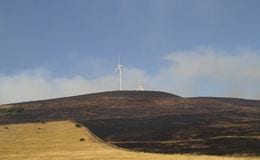 Wind turbines are essentially small buckets of lubricating oil on top of a large metal stick, with rotating wings attached. Add a strike of lightning, a short circuit or a mechanical fault and they occasionally set alight. While that might make a good photo, no one’s sure how big a problem it is. A new report tries to work it out.
Wind turbines are essentially small buckets of lubricating oil on top of a large metal stick, with rotating wings attached. Add a strike of lightning, a short circuit or a mechanical fault and they occasionally set alight. While that might make a good photo, no one’s sure how big a problem it is. A new report tries to work it out.
The research by a group of academics from the University of Edinburgh and Imperial College London for the International Association for Fire Safety Science (IAFSS) tries to assess how common wind turbine fires are and how dangerous they might be. But the researchers ran into a problem: there’s not much data available.
Fire data
When looking for data on wind turbine fires, the researchers found many “sources of information are incomplete, biased, or contain non-publically available data”. So it’s hard to reliably assess the extent of the problem.
Nonetheless, the researchers give it a go using data from the – admittedly fairly biased – Caithness Windfarm Information Forum (CWIF). That’s an anti-windfarm campaign group, so you can be sure they’ve done their best to record as many and as serious accidents as possible.
The CWIF recorded a total of 1,328 accidents involving wind turbines between 1995 and 2012. Of those, 200 involved fire. There have been no recorded fatalities and four recorded injuries from wind turbine fires, the IAFSS report says.
That’s 11.7 fires per year on average, or nearly one a month, the research points out.
While that might sound like a lot, in 2012 there were 225,000 wind turbines installed globally, according to trade association the Global Wind Energy Council. That means you could expect there to be one fire a year for every 19,230 turbines operating worldwide, on average. There are 5,569 in the UK.
Data sources
Of course, analysis is only as good as the data that underpins it. Where does the anti-windfarm group CWIF get its data? Much of it comes from press reports, so is likely to be reliable. The database also draws on “private” reports sent to the CWIF and YouTube videos – and includes things like roof-mounted domestic wind turbines catching fire, as well as data from larger windfarms.
One big chunk of the fire reports – 69 out of the 200 – come from a company called Arepa. Here’s a sample of Arepa’s data. The firm is in the business of repairing things after accidents, including fires, and almost all of its reports say they carried out “restoration”. You wouldn’t restore a turbine that has failed catastrophically – you’d write it off. That tells us many of the fires recorded in the underlying data are likely to be minor.
Ten times more fires?
One fire a month around the world doesn’t sound like a lot, particularly if a proportion of those fires are minor.
But according to a report of the new research in the Telegraph under the headline “Wind turbine fires ‘ten times more common than thought’, experts warn”, CWIF’s data may not reveal the whole story, and the real number could be ten times higher. Where does this figure come from?
The researchers say trade body Renewable UK told them there had been 1,500 accidents involving wind turbines between 2006 and 2010, around ten times more than the CWIF data recorded for the same time period.
If there were ten times as many accidents, then surely there would have been ten times as many fires, the researchers assume. In that case there could have been as many as 117 fires a year on average.
There’s a really big issue with this assumption, however. Renewable UK director of health and safety Chris Streatfeild tells Carbon Brief that the 1,500 figure is for “incidents” not “accidents”. What’s the difference? Incidents includes minor slips, trips or falls as well as actual accidents.
Streatfield says:
“These are overwhelmingly near events where no injury, harm or damage resulted. Far from being a negative – reporting of this type is an example of industry good practice in that it enables safety improvements to be made before more serious events occurs. The extrapolation in applying the data to fire safety by the researchers is therefore extremely misleading.”
He says that it isn’t possible to break the figure down to show the number of fires because the data is recorded according to the severity of the incident rather than according to what type of incident it was.
That means the 11.7 fires per year is more likely to be a maximum rather than a minimum figure. In fact, once we take out the four restorable (so probably minor) fires per year repaired by Arepa there are actually fewer serious fires than thought, not more.
Business problem
Given the relatively low numbers of fires and the fact that they don’t tend to occur in built up areas or spread particularly quickly, wind turbine fires are probably not putting many people in danger.
But that doesn’t mean they’re not a problem, particularly for windfarm operators who lose money every time a turbine needs to be prepared. Germany’s fire testing organisation, the VdS, estimates that an operator can lose €5,000 a week if a 20-year old two megawatt turbine is out of operation, the report says. It also quotes another estimate that suggests one offshore wind turbine fire ended up costing a company about €2 million in repairs and lost revenue.
If that’s the case, there’s a pretty big incentive for companies to ensure their kit is fireproof. Streatfield points out – not unreasonably – that the industry wouldn’t be able to secure the billions being invested in wind energy if that money was at significant risk.
Source: The Carbon Brief. Reproduced with permission.






